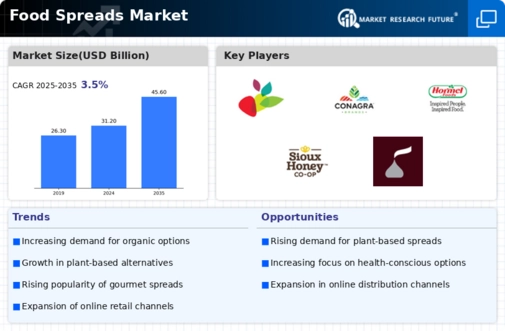Market Share
Food Spreads Market Share Analysis
The Food Spreads market is influenced by a number of factors that affect its dynamics as well as growth patterns. One of the leading drivers of this market, though, is changing consumer breakfast habits and preferences. They want something that is handy and flexible to spread on bread for breakfast when changing their breakfast routines. This has made food spreads such as jams, jellies, nut butters and chocolate spread important in many homes because they are easy to use while giving taste to morning meals.
Food Spreads market is significantly influenced by health consciousness as well. The growing emphasis on healthier eating patterns has resulted in an increase for spreads that align with wellness goals. In particular, this trend has seen the popularity of nut butters—almonds, peanuts or other nuts based which are considered healthy alternatives without added sugars compared with traditional kinds – boom. Therefore, companies have been launching healthier versions like reduced sugar or using natural sweeteners targeting consumers who mind about their well-being.
Another major driver of the Food Spreads market stems from a global shift towards plant-based diets plus veganism rise. This is why fruit preserves, hummus or vegetable-based ones have become more popular than animal derived products among consumers. Manufactures resonate with these dietary preferences since they touch upon ethical issues together with environmental and health related matters so that producers are diversifying their range through incorporating plant-based spreads into product lines thus responding to increasing demand.
Diversity of products and flavor innovations are also shaping Food Spreads market greatly. At this time than ever before, they want unique flavors when it comes to them consuming different kind of spreads because they like new experiences concerning taste buds causing a high demand for exotic tastes through these groups who love trying out different things in life presently. Consequently, there are productions like fruit infused nut butters spicy jam or confectionery paste for gourmet chocolates which have been introduced by producers within their domain recently. New combinations such as fruit-infused nut butters, spicy jams and gourmet chocolate spreads have since been introduced by producers. This focus on varied and interesting flavors helps keep the industry alive and attracts consumers who love experiencing new tastes.
Additionally, packaging innovations coupled with sustainability initiatives play a significant role in shaping the Food Spreads market. Some companies use eco-friendly packaging materials like glass jars or recyclable ones. Furthermore, modern consumer preferences are more inclined to on-the-go and portion-controlled options hence the popularity of single serving convenient sachets.
Economic factors like income levels and consumer spending power determine whether Food Spreads market can be made preimmunized against. Premium as well as artisanal spreads are targeted to those rich customers who prefer gourmet food products buying only. The market is diverse because it has cheaply priced spreads while at the same time have expensive brands accommodating different people according to what they can afford to buy.
Similarly, there is global supply chain dynamics which affects global Food Spreads market through its availability of raw material including their pricing aspects. As a result, changes in cost of fruits, nuts or cocoa can affect overall production costs for spreads. Additionally, weather patterns together with geopolitical activities in key sourcing areas may impact supply chains thereby resulting into price changes and fluctuation in product availability within these regions too.
In the Food Spreads market, consumer education and awareness campaigns significantly impact buying decisions. In fact, health professionals, nutritionists, and food bloggers have also played a big role in public education on the nutritional benefits of these food spreads and how they can be used in a healthy diet. This means consumers become more aware about the ingredients, sourcing and health implications of spreads which makes them choose those that meet their personal preferences and goals.
This includes factors such as brand recognition, marketing strategies, and product positioning. Established brands will often use their track record to keep hold of their market share while smaller artisanal brands may concentrate more on unique selling points as well as premium quality. Thus, it follows that with respect to brand visibility and customer loyalty marketing should consider elements such as the naturalness of ingredients used in making spreads, sustainable sourcing.
The cultural preferences also shape trends within the Food Spreads market. The different areas possess diverse tastes hence some types of spreads gain popularity than others. Some regions might prefer fruit preserves that are less sweet than spicier or savory ones thus makers keen on succeeding in varied markets have to learn these cultural nuances.









Leave a Comment